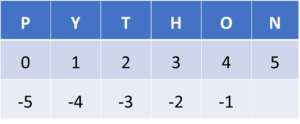Data Science with Python Certification Course
- 131k Enrolled Learners
- Weekend
- Live Class
A string is a sequence of Unicode character/s. String consists of a series or sequence of characters that may contain alphanumeric and special characters. In this article, we will understand substring in python and how it works in the following manner:
In python substring is a sequence of characters within another string, In python, it is also referred to as the slicing of string.
s= s[ startIndex : endIndex]
Please Note: index start from 0 in a string.
s= s[ startIndex :]
# Slicing or substring using start, without end index s= 'This is to demonstrate substring functionality in python.' s[5:] Output : 'is to demonstrate substring functionality in python.'
Returns a sliced string from the string which starts from index position 5 till the end of the string.
s= s[: endIndex]
# Slicing or substring without start index s= 'This is to demonstrate substring functionality in python.' s[:7] Output: 'This is'
Returns a sliced string from start to end-index-1.
s= s[:]
# Slicing or substring without start or end index s= 'This is to demonstrate substring functionality in python.' s[:] Output: 'This is to demonstrate substring functionality in python.'
Returns the complete string.
s= s[index]
# Slicing or substring single character s= 'This is to demonstrate substring functionality in python.' s[9] Output: ‘o’
Return single character.
Slicing using start-index, end-index and step
s= s[startIndex : endIndex: step]
# Slicing or substring with start-index, end-index and step. s= 'This is to demonstrate substring functionality in python.' s[12:22:1] Output: ‘emosntrate’
When step size is one it is similar to normal slicing.
# Slicing or substring with start-index, end-index and step. s= 'This is to demosntrate substring functionality in python.' s[12:22] Output: ‘emosntrate’
When step size is 2 then it slices out in steps of 2
# Slicing or substring with start-index, end-index and step. s= 'This is to demonstrate substring functionality in python.' s[12:22:2] Output: ‘eonrt’
For example, with step size 1 sliced string is emosntrate
with step size 2 sliced string is emosntrate, which shows slicing in step size 2.
Similarly, for step size 3 it will be emosntrate.
# Slicing or substring with start-index, end-index and step. s= 'This is to demonstrated substring functionality in python.' s[12:22:3] Output: ‘esre’
# Reverse a string using Slicing or substring with negative step. s= 'This is to demonstrated substring functionality in python.' s[::-1] Output: ‘.nohtyp ni ytilanoitcnuf gnirtsbus etartnsomed ot si sihT’
Working with negative index

The index in string starts from 0 to 5, alternatively we can use a negative index as well.
# Slicing or substring a string using negative index. s= 'PYTHON' s[0:-3] Output: ‘PYT’
# Slicing or substring a string using positive index. s= 'PYTHON' s[0:3] Output: ‘PYT’
# Get all substrings of string using list comprehension and string slicing
s= 'PYTHON'
str=[s[i: j]
for i in range(len(s))
for j in range(i + 1, len(s) + 1)]
print (str)
Output: ['P', 'PY', 'PYT', 'PYTH', 'PYTHO', 'PYTHON', 'Y', 'YT', 'YTH', 'YTHO', 'YTHON', 'T', 'TH', 'THO', 'THON', 'H', 'HO', 'HON', 'O', 'ON', 'N']
# Get all substrings of string using list comprehension and string slicing
s= 'PYTHON'
str=[s[i: j]
for i in range(len(s))
print (str)
Output: ['P', 'PY', 'PYT', 'PYTH', 'PYTHO', 'PYTHON', 'Y', 'YT', 'YTH', 'YTHO', 'YTHON', 'T', 'TH', 'THO', 'THON', 'H', 'HO', 'HON', 'O', 'ON', 'N']
# Check if string is present within another string using in operator
s= 'This is to demonstrated substring functionality in python.'
print("This" in s)
print("Not present" in s)
Output:
True
FalseIn operator will return true if a substring is present within another string else will return false.
# Check if string is present within another string using find method
s= 'This is to demonstrated substring functionality in python.'
print(s.find("demonstrate"))
print(s.find("Not present"))
Output:
11
-1Find method will print the index if a substring is present within another string else will return -1 if a string is not present.
With this, we come to an end of this Substring in Python article. I hope you got an idea of slicing and how it helps to create different types of substrings in python.
To get in-depth knowledge on Python along with its various applications, you can enroll now for live online Python training with 24/7 support and lifetime access.
 Thank you for registering Join Edureka Meetup community for 100+ Free Webinars each month JOIN MEETUP GROUP
Thank you for registering Join Edureka Meetup community for 100+ Free Webinars each month JOIN MEETUP GROUPedureka.co